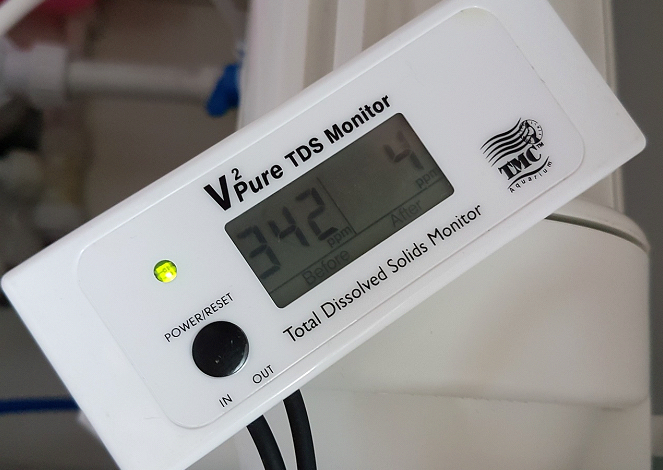How to Test TDS Levels for Drinking Water and Why it Matters

Clean drinking water is a basic necessity for everyone’s health and well-being. It is essential that we have access to clean and safe drinking water. However, water quality can vary significantly depending on its source and treatment. One important factor to consider is the Total Dissolved Solids (TDS) level of your drinking water.
TDS is a measure of the amount of inorganic and organic substances present in the water. High TDS levels can indicate the presence of harmful contaminants, such as lead or arsenic, which can pose serious health risks over time. As a result, it’s important to know how to test the TDS levels of your drinking water to ensure it’s safe for consumption. In this article, we’ll explore the different methods for testing TDS levels and provide you with the knowledge you need to make an informed decision about the quality of your drinking water.
What is TDS and Why is it Important to Measure?
TDS stands for Total Dissolved Solids, and it’s a measure of the total amount of inorganic and organic substances that are dissolved in water. TDS levels can be measured in parts per million (ppm) or milligrams per liter (mg/L). These dissolved solids can be anything from minerals, salts, metals, and chemical compounds. Some of these substances are essential for our health, such as magnesium and calcium, while others can be harmful, such as lead or arsenic.
TDS levels can vary significantly depending on the source of the water. Groundwater sources like wells and springs tend to have higher TDS levels than surface water sources like rivers and lakes. Additionally, the treatment process used to purify the water can also affect the TDS levels. Municipal water treatment plants use a variety of methods to purify the water, such as filtration, disinfection, and chemical treatments, which can all impact the TDS levels.
Measuring TDS levels is important because it can indicate the quality and safety of drinking water. High TDS levels can indicate the presence of harmful contaminants, such as lead or arsenic, which can pose serious health risks over time. As a result, it’s important to regularly test the TDS level of drinking water to ensure it’s safe for consumption.
How to Test TDS Levels for Drinking Water
There are several methods for testing TDS levels in drinking water. The most common method is to use a TDS meter, which is a small handheld device that measures the conductivity of water. This conductivity measurement is then converted into a TDS reading.
To use a TDS meter, follow these steps:
1. Turn on the TDS meter and let it warm up for a few minutes.
2. Fill a clean glass with the water you want to test.
3. Insert the TDS meter into the water and stir gently for a few seconds.
4. Wait for the reading to stabilize, then record the TDS reading.
5. Rinse the TDS meter with clean water and store it in a dry place.
It’s important to note that TDS meters are not 100% accurate and can give false readings if not used correctly. Additionally, TDS meters only measure the total amount of dissolved solids in the water and cannot identify specific contaminants.
Another method for testing TDS levels is to use a TDS test kit, which is a chemical test that uses a color-changing strip to indicate the TDS levels. To use a TDS test kit, follow these steps:
1. Fill a clean glass with the water you want to test.
2. Dip the color-changing strip into the water for a few seconds.
3. Remove the strip from the water and wait for the color to change.
4. Match the color of the strip to the color chart that came with the kit to determine the TDS level.
TDS test kits are generally less accurate than TDS meters and can be affected by factors such as temperature and the presence of other substances in the water.
Different Methods of Testing TDS Levels
There are several different methods for testing TDS levels, each with its own advantages and disadvantages.
The most common method is to use a TDS meter, which is quick and easy to use. TDS meters are also relatively inexpensive and widely available. However, TDS meters can be affected by factors such as temperature and the presence of other substances in the water, which can affect the accuracy of the readings.
Another method for testing TDS levels is to use a TDS test kit. TDS test kits are generally less accurate than TDS meters but can be useful for occasional testing or for situations where a TDS meter is not available.
Laboratory testing is another option for testing TDS levels. This method involves sending a water sample to a certified laboratory for analysis. Laboratory testing is the most accurate method for testing TDS levels, but it is also the most expensive and time-consuming.
Interpreting TDS Readings and What They Mean
TDS readings can vary significantly depending on the source and treatment of the water. In general, TDS levels of less than 500 ppm are considered safe for drinking, while levels above 1000 ppm may be cause for concern.
However, it’s important to remember that TDS levels alone cannot determine the safety of drinking water. Other factors, such as specific contaminants and their concentration, must also be considered.
If your TDS levels are high, it may indicate the presence of harmful contaminants such as lead or arsenic. In this case, it’s important to identify the source of the contamination and take steps to remove it. This may involve installing a water filtration system or switching to a different source of drinking water.
Ideal TDS Levels for Drinking Water
The ideal TDS level for drinking water depends on several factors, including the source and treatment of the water and individual health considerations. In general, TDS levels of less than 500 ppm are considered safe for drinking, while levels above 1000 ppm may be cause for concern.
However, it’s important to remember that TDS levels alone cannot determine the safety of drinking water. Other factors, such as specific contaminants and their concentration, must also be considered. Additionally, some dissolved solids, such as minerals like calcium and magnesium, can have health benefits in small amounts.
Common Sources of High TDS Levels in Drinking Water
There are several common sources of high TDS levels in drinking water. Groundwater sources like wells and springs tend to have higher TDS levels than surface water sources like rivers and lakes. Additionally, the treatment process used to purify the water can also affect the TDS levels. Municipal water treatment plants use a variety of methods to purify the water, such as filtration, disinfection, and chemical treatments, which can all impact the TDS levels.
Other common sources of high TDS levels include industrial and agricultural runoff, as well as natural sources such as rock formations and soil.
Ways to Reduce TDS Levels in Drinking Water
If your TDS levels are high, there are several ways to reduce them. The most effective method is to install a water filtration system, which can remove dissolved solids and other contaminants from the water. There are several different types of water filtration systems available, including reverse osmosis, activated carbon, and distillation.
Another option is to switch to a different source of drinking water. Surface water sources like rivers and lakes tend to have lower TDS levels than groundwater sources like wells and springs. Additionally, choosing a water source that is located far away from industrial and agricultural areas can also help to reduce TDS levels.
Importance of Regular TDS Testing for Water Quality
Regular testing of TDS levels is important for ensuring the safety and quality of drinking Water TDS levels can vary significantly depending on the source and treatment of the water, as well as other factors such as climate and season. Additionally, TDS levels can fluctuate over time, so it’s important to test regularly to ensure that the water remains safe for consumption.
By regularly testing TDS levels, you can identify any changes in water quality and take steps to address them before they become a health concern. This may involve installing a water filtration system or switching to a different source of drinking water.
Conclusion and Key Takeaways
In conclusion, TDS levels are an important factor to consider when it comes to the safety and quality of drinking water. High TDS levels can indicate the presence of harmful contaminants, such as lead or arsenic, which can pose serious health risks over time. Regular testing of TDS levels is essential for ensuring the safety of drinking water.
There are several methods for testing TDS levels, including using a TDS meter, a TDS test kit, or laboratory testing. It’s important to interpret TDS readings in the context of other factors, such as the specific contaminants present in the water.
If your TDS levels are high, there are several ways to reduce them, including installing a water filtration system or switching to a different source of drinking water. By regularly testing TDS levels and taking steps to address any issues, you can ensure that your drinking water is safe and healthy for you and your family.





